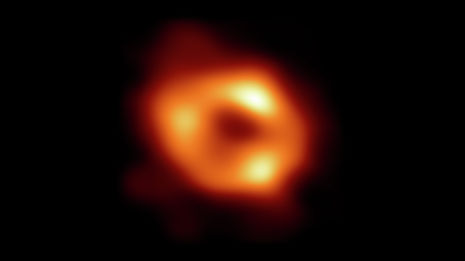These new images of a black hole are groundbreaking
Tom Howarth explains the significance of the recent progress in black hole imaging

On the 12th of May 2022, at simultaneous press conferences around the globe, astronomers of the Event Horizon Telescope (EHT) Collaboration unveiled the first-ever direct images of the black hole situated at the centre of our galaxy – Sagittarius A*. This blurry picture is the culmination of 5 years of data analysis by a team of over 300 researchers working at 80 institutes worldwide and provides us with overwhelming evidence that the long hypothesised supermassive black hole at the centre of the Milky Way is in fact really there.
A black hole is a region of dense matter in space where the gravity is so intense that nothing, not even light, can escape if it gets too close. This characteristic has, until recently, made them impossible to image despite astronomers’ theories that these giants may lie at the centre of most observable galaxies. While the black hole is not directly visible in the picture, the dark region at the centre of the image – known as the ‘shadow’ – reveals its presence. The orange rings surrounding the shadow are clouds of hot glowing gas, heated to a trillion degrees as they orbit the black hole.
“The team effectively created an ‘Earth-sized’ telescope with the highest resolution of any instrument to date”
Sagittarius A* lies some 27,000 light-years from the Earth and is obscured by gas and dust that blocks any visible light from passing through. Therefore, to capture the image, the team had to employ a network of 8 radio telescopes situated across the globe, effectively creating an ‘Earth-sized’ telescope with the highest resolution of any instrument to date. Using a technique known as Very Long Baseline Interferometry (VLBI), this super-telescope can peer through the obstructive veil of the Milky Way and record radio waves which pass through unimpeded.
In April 2017, the EHT was pointed to the skies and spent ten nights gathering over 65 hours of data from several predicted black holes, which was then processed using supercomputer banks in the USA and Germany. The first significant results of this labour-intensive process were seen in 2019 when the EHT Collaboration released the first-ever images of a black hole - M87*, the galactical core of the Messier 87 galaxy. The data from this black hole was somewhat easier to convert into an image than for Sagittarius A*, which would take three further years of processing before it could be displayed to the world.
“This is likely to be just the tip of the iceberg of revelations to be gained from the data”
The reason behind the delay is that Sagittarius A*, whilst being almost 4 million times more massive than our own sun, is actually much smaller than M87*, which means that the gas orbiting Sagittarius A* – that travels at a significant fraction of the speed of light – completes its orbit in just minutes. The result is that the brightness pattern around Sagittarius A* is rapidly changing, making compiling a clear image from the data collected a computationally mammoth task. To do this, the team had to develop sophisticated new tools that could essentially average the different images, account for the gas movement, and produce the final picture.
But this project is about more than just creating pretty visualisations of these mysterious celestial bodies; it also hopes to improve our understanding of them and how they interact with their surroundings. The sizes of the rings, for example, have already demonstrated remarkable agreement with predictions from Einstein’s Theory of General Relativity and is likely to be just the tip of the iceberg of revelations to be gained from the data. Now armed with two images of black holes of very different sizes, scientists will be able to test new theories and models as they compare the two. Such theories could unlock key insight into how black holes interact with surrounding gas and dust, which is thought to play a major role in how galaxies like ours form and evolve.
And this is not all: in March 2022, the EHT launched its second major data collection campaign, employing even more telescopes than before. The hope is that with the addition of extra recording capabilities along with significant technological upgrades to the current system, astronomers will be able to produce clearer images and even some video footage of black holes in the very near future. Keep your eyes peeled.
 News / Eight Cambridge researchers awarded €17m in ERC research grants27 December 2025
News / Eight Cambridge researchers awarded €17m in ERC research grants27 December 2025 News / Downing investigates ‘mysterious’ underground burial vault 29 December 2025
News / Downing investigates ‘mysterious’ underground burial vault 29 December 2025 Lifestyle / Ask Auntie Alice29 December 2025
Lifestyle / Ask Auntie Alice29 December 2025 Sport / Hard work, heartbreak and hope: international gymnast Maddie Marshall’s journey 29 December 2025
Sport / Hard work, heartbreak and hope: international gymnast Maddie Marshall’s journey 29 December 2025 Interviews / Meet Juan Michel, Cambridge’s multilingual musician29 December 2025
Interviews / Meet Juan Michel, Cambridge’s multilingual musician29 December 2025









